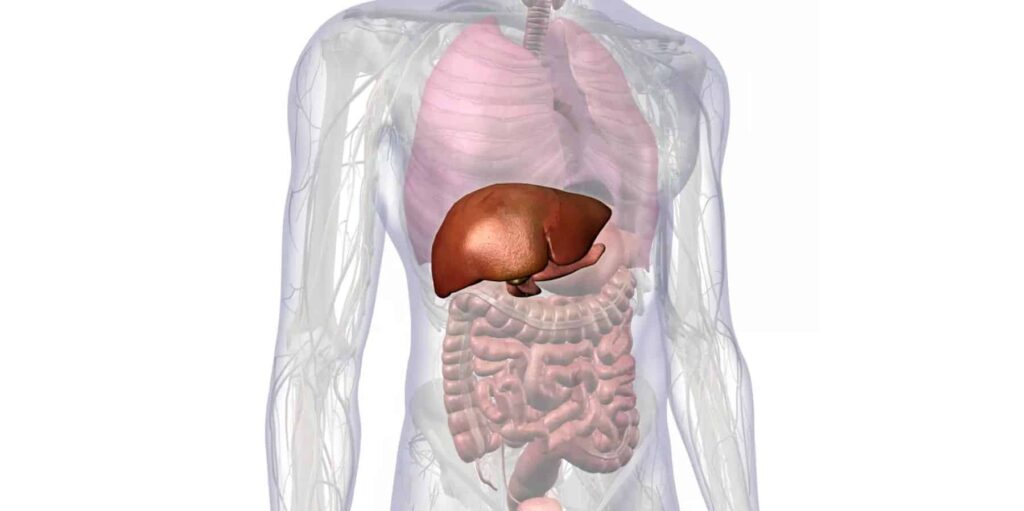What is Non-Alcoholic Fatty Liver Disease (NAFLD)?
Non-alcoholic fatty liver disease (NAFLD) is a disease of the liver affecting people who drink little to no alcohol. As the name implies, the main characteristics of NAFLD is too much fat stored in liver cells
NAFLD is the most common liver disease in Canada affecting about 20% of Canadians. It tends to develop in people who are overweight or obese, particularly if they have a lot of fat around their middle. Having said this, it can also develop in someone of healthy body weight, but who typically eats a lot of sugary and fatty foods and who may be carrying just a few extra pounds around their waistline. NAFLD has shown to be strongly associated with metabolic syndrome—a health disorder characterized by a group of risk factors (large waist circumference, high blood pressure, high blood sugar levels, high cholesterol, and abnormal amounts of lipids in the blood) that greatly increase the risk of many chronic illnesses.
What causes NAFLD?
The most common cause of fatty liver disease in Canada is obesity. In 2018, almost 30% of Canadians 18 and older (roughly 7.3 million adults) reported height and weight that classified them as either overweight or obese.
Additional causes include:
- Starvation and protein malnutrition
- Long-term use of total parenteral nutrition (a feeding procedure that involves infusing nutrients directly into the bloodstream)
- Intestinal bypass surgery for obesity
- Rapid weight loss
- Genetic factors
- Drugs and chemicals
In coordination with our western diet the following medical conditions often accompany and may contribute to fatty liver disease:
- Diabetes mellitus
- Hyperlipidemia (elevated lipids in the blood)
- Insulin resistance and high blood pressure
How does fat get into the liver?
Fat and sugars from our diet are usually broken down by the liver and other tissues. If the amount of fat or simple sugar intake exceeds what is required by the body then fat is stored as fatty tissue. Other reasons for the accumulation of fat in the liver could be the transfer of fat from other parts of the body or the inability of the liver to change it into a form that can be eliminated.
What are the symptoms?
In general, people with fatty liver disease have no outward symptoms. However, some people report discomfort in the abdomen at the level of the liver, fatigue, a general feeling of being unwell, and vague discomfort.
How is NAFLD diagnosed?
Fatty liver disease is usually suspected in people who are overweight and obese, who have evidence of dyslipidemia (high cholesterol and lipids in the blood), insulin resistance and/or abnormal liver enzyme tests.
An ultrasound of the liver can show the presence of a fatty liver. In some cases, your doctor may advise a liver biopsy, a procedure where the physician inserts a needle into the liver and extracts sample tissue, which is then examined under a microscope.
Treatment of NAFLD.
When there is a buildup of simple fat, the liver becomes vulnerable to further injury, which may result in liver inflammation and scarring. The treatment of fatty liver disease is related to the cause.
The treatment for NAFLD has not yet been well established and people are advised to address their risk factors (i.e., to improve their blood sugar control/monitoring if they are diabetic and to achieve gradual and sustained weight loss). Reducing or avoiding alcohol consumption and lifestyle modification are recommended. Individuals losing a minimum of 5% body weight can achieve significant improvement.
Nutrition and Supplements
A change in diet plays a significant part in how NAFLD may be treated and certainly how it can be prevented. Consuming too much sugar and saturated fat in your diet can have a similar effect as too much alcohol—fat build-up in the liver. Although there is no specific ‘liver healthy diet,’ these general guidelines of what and how much to eat can help ensure that your liver is functioning at its best! The Mediterranean and DASH (Dietary Approaches to Stop Hypertension) diets are still recommended.
Milk Thistle, a prickly yet pretty plant with a long, thin stem, spiny leaves, and a purplish-pink thistle at the top, often considered a weed, has been used for hundreds of years as a natural herbal way to treat liver and gallbladder diseases. It’s sometimes called silymarin, which is one of the main components of the plant’s seeds. The terms milk thistle and silymarin are often used interchangeably, even though they aren’t exactly the same thing.
Vitamin E administered at a daily dose of 800 IU/day may improve liver tissue in nondiabetic adults but more studies are needed to provide supporting data.
Medical research on milk thistle and liver health has led to mixed results. Studies show that silymarin may help ease inflammation and promote cell repair within the liver. This may help ease symptoms from liver diseases like jaundice, cirrhosis, liver cancer, and fatty liver disease. However, other studies don’t show any effect against another liver disease such as Hepatitis C, which is a viral infection.
Physical Activity
Recognizing the difference between physical activity and exercise is the first step to living a lifestyle filled with more movement! While exercise is something best done with a moderate to high intensity and a structured routine, the goal of physical activity is to do anything you can that gets you moving and can be physically demanding. It is important to decrease your sedentary time.
Sleep and Your Overall Health
Sleep affects so many parts of life like our mental health, and it should be valued just as much as eating right and getting enough physical activity throughout the day. Many Canadians do not get enough sleep, and insufficient sleep has been linked to a number of poor physical and mental health concerns, including an increased risk for developing a fatty liver. Lack of sleep can contribute to changes in your overall metabolism (like insulin resistance) that may affect the way your liver converts nutrients from the foods you eat, making it harder to maintain healthy body weight. It can also make you feel more tired and sleepy during the day which also affects your overall physical activity level.
Health Canada recommends that getting at least 7-9 hours of sleep per night for adults is essential to maintain your health.
Are you at risk of developing NAFLD? For more information or to take this quick quiz from the Canadian Liver Foundation:
https://www.liver.ca/wp-content/uploads/2019/02/NAFLD-Quiz-EN_2-1.pdf
Need supplements or additional support? Call our West Block location and book some time with our in-house Naturopath, Dr. Chi Hung La.





